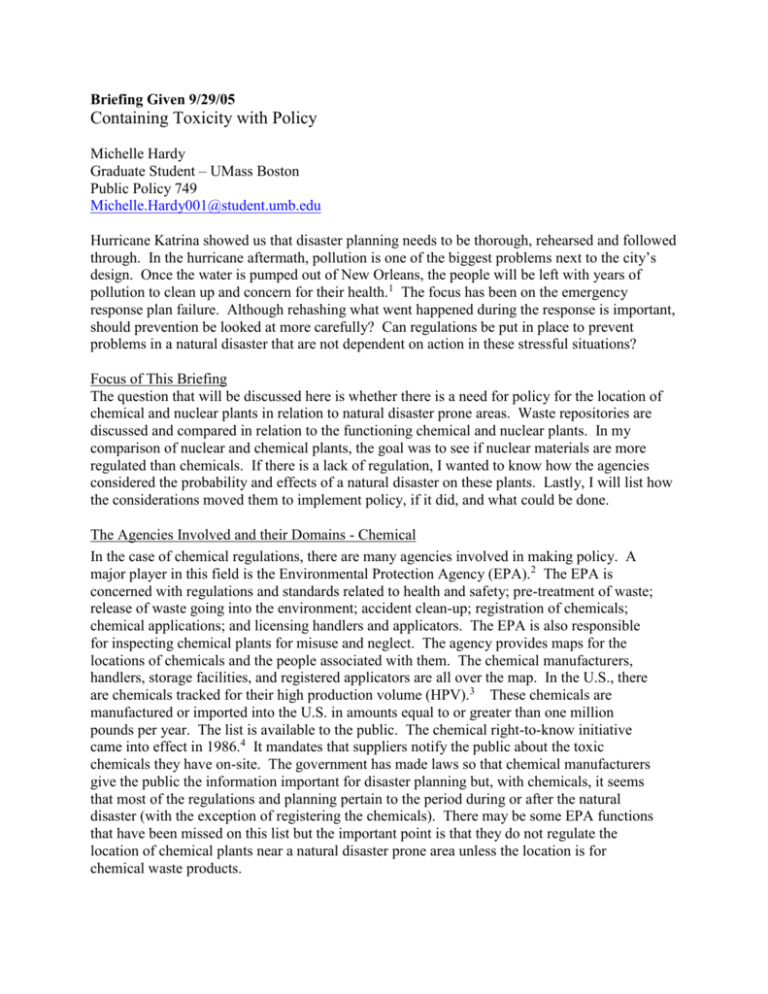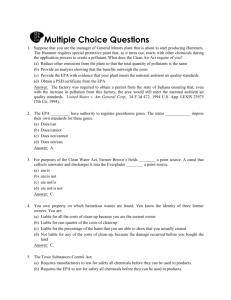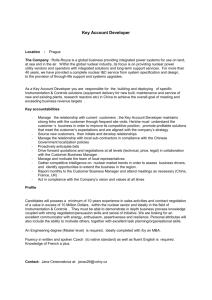handout
advertisement

Briefing Given 9/29/05 Containing Toxicity with Policy Michelle Hardy Graduate Student – UMass Boston Public Policy 749 Michelle.Hardy001@student.umb.edu Hurricane Katrina showed us that disaster planning needs to be thorough, rehearsed and followed through. In the hurricane aftermath, pollution is one of the biggest problems next to the city’s design. Once the water is pumped out of New Orleans, the people will be left with years of pollution to clean up and concern for their health.1 The focus has been on the emergency response plan failure. Although rehashing what went happened during the response is important, should prevention be looked at more carefully? Can regulations be put in place to prevent problems in a natural disaster that are not dependent on action in these stressful situations? Focus of This Briefing The question that will be discussed here is whether there is a need for policy for the location of chemical and nuclear plants in relation to natural disaster prone areas. Waste repositories are discussed and compared in relation to the functioning chemical and nuclear plants. In my comparison of nuclear and chemical plants, the goal was to see if nuclear materials are more regulated than chemicals. If there is a lack of regulation, I wanted to know how the agencies considered the probability and effects of a natural disaster on these plants. Lastly, I will list how the considerations moved them to implement policy, if it did, and what could be done. The Agencies Involved and their Domains - Chemical In the case of chemical regulations, there are many agencies involved in making policy. A major player in this field is the Environmental Protection Agency (EPA).2 The EPA is concerned with regulations and standards related to health and safety; pre-treatment of waste; release of waste going into the environment; accident clean-up; registration of chemicals; chemical applications; and licensing handlers and applicators. The EPA is also responsible for inspecting chemical plants for misuse and neglect. The agency provides maps for the locations of chemicals and the people associated with them. The chemical manufacturers, handlers, storage facilities, and registered applicators are all over the map. In the U.S., there are chemicals tracked for their high production volume (HPV).3 These chemicals are manufactured or imported into the U.S. in amounts equal to or greater than one million pounds per year. The list is available to the public. The chemical right-to-know initiative came into effect in 1986.4 It mandates that suppliers notify the public about the toxic chemicals they have on-site. The government has made laws so that chemical manufacturers give the public the information important for disaster planning but, with chemicals, it seems that most of the regulations and planning pertain to the period during or after the natural disaster (with the exception of registering the chemicals). There may be some EPA functions that have been missed on this list but the important point is that they do not regulate the location of chemical plants near a natural disaster prone area unless the location is for chemical waste products. The Department of Transportation (DOT) makes sure that chemicals are moved safely.5 The Occupational Safety and Health Administration (OSHA)6 makes standards for companies and employees related to employee safety. The local agencies and organizations seem to be involved with granting the permits for industrial chemical company locations. These local entities include the Governors, state agencies, tribal councils, unions, and concerned citizen organizations.7 The American Chemistry Council, which was formally the Chemical Manufacturers of America, is the voice of the chemical industry across America. The American Chemistry Council is an example of a non-governmental agency helping to enforce government regulations. The Council helped establish CHEMTREC8 (Chemical Transportation Emergency Center), a public service hotline for fire fighters, law enforcement, and other emergency responders to obtain information and assistance for emergency incidents involving chemicals and hazardous materials. Shippers of hazardous materials can comply with US federal and state safety regulations by registering with CHEMTREC. CHEMTREC is a 24/7 resource that coordinates and communicates a broad range of critical information that may be needed by emergency responders in mitigating a hazardous material related incident. The Agencies Involved and their Domains - Nuclear The Department of Energy, the Nuclear Regulatory Commission (NRC), the Environmental Protection Agency (EPA), and the Department of Transportation (DOT) enact the nuclear regulations.9 There are several organizations that act as advisors and provide oversight. These include the National Academy of Sciences; the Office of Nuclear Material Safety and Safeguards; the Nuclear Waste Technical Review Board; the NRC, state and project scientists; the governor; city officials; tribal councils; and concerned citizens. This list does not contain all the people and agencies involved but the important fact is that there are agencies that make the regulations, others that provide expert advice, and oversight, and still others that fight the decisions if they do not like them. The locations for the nuclear power plants are limited to areas where there is a large source of water and proximity to the power grid or a large population.10 The water source is needed to keep the reactor cool.11 Nuclear materials need more safeguards than chemical materials because their breakdown is slower when contained, the danger to humans is more immediate and far reaching, and they persist in the environment longer. Nuclear waste is stored near the active facilities also. It is considered short-term storage and can present a problem because it is not as heavily regulated as the long-term waste.12 Radioactive material may be in line to be recycled. Therefore, it needs to be stored, moved, and otherwise handled which gives it a greater chance to be released. Nuclear waste persists for many, many years in the environment. This is a concern and warrants strict regulations concerning long-term waste repositories. There are things that companies can do to make the waste less reactive. For example, they can transform it into glass. As a glass, it can be stored for longer periods of time without as much worry.13 Did They Consider Natural Disasters? The agencies considered natural disasters when planning for waste site repositories (long-term storage) locations but not for functioning chemical plants (short-term storage).14 We can never be sure what we will need to control for in the future so the worst has to be expected when storing hazardous wastes for long periods of time. This is probably why they regulate waste more. A canister that is perfectly safe in a dry warehouse with proper ventilation may perform much differently if it comes in contact with molten lava. Also, the degradation of all the chemicals may not be known in all conditions. It may be converted to some more lethal vapor or something else unexpected. The chemical companies may not pay close attention to chemicals that can no longer make them money if they are not inspired to do this. A famous example of neglected waste that started the formation of the superfund is Love Canal in New York. Although the government knows about the natural hazards, they did not disallow active chemical and nuclear plants from locating near them. There are several reasons why this is probably true. The chemicals are needed all over the country. Transporting chemicals is probably more hazardous statistically than locating them near a natural disaster prone area. It is difficult to find enough locations that would be considered safe for all disasters given the amount of companies. Nuclear plants need certain conditions to be safe and effective in operation so their location is limited. Are these reasons good enough if a city is destroyed as Chernobyl15 was or almost destroyed as with the Three Mile Island16 accident? Chernobyl and Three Mile Island’s accidents were not due to natural disaster but the same breakdown in the containment vessels system could have been started by a natural disaster. Lastly, we can look at New Orleans again. There are chemical plants in the floodplain of New Orleans.17 Soon we will know just how much damage they have caused and have to decide if we still want them there. What do the Regulations Cover? The functioning chemical companies must: Register their chemicals with the government and report them to the public. Comply with regulations regarding pre-treatment before their contaminated water reaches the sewers and groundwater. Comply with regulations regarding employees handling the chemicals. Comply with regulations regarding employees using the chemicals. Comply with regulations regarding releasing chemicals into the environment. Comply with regulations regarding the transport of their chemicals Comply with regulations regarding the packaging of their chemicals Comply with regulations regarding the sale of their chemicals Keep short-term storage of chemicals safe in accordance with regulations.18 They do not have to locate the facility in a particular place unless the state or local zoning board deems it necessary – usually due to water table concerns or dangers due to the type of roadways near the plant. These are the considerations for the locations of long-term waste disposal repositories. Time to travel to groundwater Weather Fault and earthquake hazard Site intrusion for theft of natural elements Site intrusion for chemicals or nuclear product Transportation Site ownership These criteria need to be reported in their application for a site license.19,20 At first look, it would seem that chemical plants should be far away from the floodplain, fault line, or landslide area as with the repositories. But, it just isn’t feasible given the amount needed to supply societies chemical needs and the amount of hazards in the country. It might be more feasible for nuclear power plants if they did not require the large water source and a community to which they deliver the energy. The government can control the waste by regulating its disposal and condensing it to safe zones. However, there have been situations where the strict regulations have been loosened for political gain or just to get something completed when the regulations are difficult to uphold.21 We, as a society, have to be careful of the choices we make for energy and the products in our lives. We have to understand the risks and make good decisions regarding their manufacture, use and disposal. If we do not understand what the situations are, we cannot fight for policy that is in our children’s and their children’s best interests. Location may not be the whole issue; our need for the facilities should be considered also. Examples Discussed During the Briefing Ogden Defense Depository, Utah22 Savannah River Site, South Carolina23 Yucca Mountain Site, Nevada24 Georgians Against Nuclear Energy, Georgia25 EPA Chemical Handlers’ Map26 EPA Superfund Site Map27 1 CNN, (8/29/05). Expert: Katrina could unleash disaster: www.cnn.com/2005/WEATHER/08/28/Katrina.doomsday/ 2 Environmental Protection Agency: www.epa.gov home page. 3 Environmental Protection Agency High Production Volume Challenge Program: www.epa.gov/chemtrk/volchall.htm 4 EPA Right-to-Know Act: www.epa.gov/tri/tridata/tri03/index.htm 5 Department of Transportation: http://hazmat.dot.gov/regs/register/register.htm 6 Occupational Safety and Health Agency: www.osha.gov. 7 City of Boston: www.cityofboston.gov/DND/obd/BRG/DI_Step1.asp 8 Caboara, M. (2004). Preventing Chemical Disasters. The Environment Times: www.environmenttimes.net/article.cfm?pageID=141 9 Mahijani, Arun PhD (Dec 2, 2003). Yucca Mountain: An Example Not to Follow. Institute for Energy and Environmental Research: http://www.ieer.org/comments/waste/yuccaitaly.html 10 Department of Energy Savannah River Site, SC: http://www.srs.gov/general/about/where1.htm 11 Ilan Lipper and Jon Stone, (accessed 10/23/05). Nuclear Energy and Society: http://www.umich.edu/~gs265/society/nuclear.htm 12 GreenvilleOnline.com (July 20, 2004). Nuclear Waste Setback for S.C.: http://greenvilleonline.com/news/opinion/2004/07/20/2004072035505.htm 13 Department of Energy Savannah River Site, SC: http://www.srs.gov/general/programs/solidification/index.htm 14 Dawson, B. (2002). Federal Board Concludes Current Chemical Regulations Are Inadequate. Report from the Center for Public Policy. 15 U.S. Nuclear Regulatory Commission (accessed 9/29/05). Fact Sheet on the Accident at Three Mile Island: www.nrc.gov/reading-rm/doc-collections/fact-sheets/3mile-isle.html 16 U.S. Nuclear Regulatory Commission (accessed 9/29/05). Fact Sheet on the Accident at Chernobyl Nuclear Power Plant: www.nrc.gov/reading-rm/doc-collections/fact-sheets/fschernobyl.html 17 CNN (8/29/05). Expert: Katrina could unleash disaster: www.cnn.com/2005/WEATHER/0828/Katrina/doomsday/ 18 Environmental Protection Agency: http://www.epa.gov/ebtpages/complianceenforcement.html 19 Nevada Agency for Nuclear Projects (1998), State of Nevada and Related Findings Indicating that the Proposed Yucca Mountain Site is Not Suitable for Development as a Repository: http://www.state.nv.us/nucwaste/yucca/nuctome2.htm 20 Nevada Seismological Laboratory (accessed 9/27/05). FAQs on Seismicity Near Yucca Mountain: www.seismo.unr.edu/htdocs/ym-faq.html 21 Kamps, Kevin and Mariotte, Michael (March 4, 2000). Stop DOE From Changing the Rules in the Middle of the Game on the Proposed Yucca Mountain Dump: http://www.nirs.org/alerts/03-04-2000/1 22 U.S. Environmental Protection Agency (2005). Region 8 – Completed NPL Sites: Ogden Defense Depot: www.epa.gov/region 8/superfund/sites/ut/ddou.html 23 U.S. Department of Energy Savannah River Site: http://www.srs.gov/general/srs-home.html 24 Office of Civilian Radioactive Waste Management (accessed 9/27/05). Yucca Mountain Project: www.ocrwm.doe.gov/ymp/index.shtml 25 Carroll, G.; Lyman, Edwin S.; and Curran, Diane (Dec 13, 2001). Georgia Environmental Group Wins Hearing on Plutonium Fuel (MOX) Plant Proposed for DOE’s Savannah River Site: www.nci.org/01NCI/12/pr-gane.htm 26 EPA EnviroMapper StoreFront: http://www.epa.gov/enviro/html/em/ 27 National Priorities List Sites in the United States: http://www.epa.gov/superfund/sites/npl/npl.htm Additional Resources Dymon, U.J. (accessed 9/29/05). Mapping – The Missing Link in Reducing Risk Under SARA III: www.piercelaw.edu/risk/vol5/fall/dymon.htm EPA History of Mixed Waste: http://www.epa.gov/rpdweb00/mixed-waste/mw_pg4.htm Environmental Report for the Exelon Generation Company, LLC Early Site Permit, DEL-096-Rev0. Government of Japan (2005). National Report of Japan on Disaster Reduction for the World Conference on Disaster Reduction, Kobe-Hyogo, Japan. Okumura, T., MD, PhD; Ninomiya, N. MD, PhD.; Ohta, M., MD, PhD. (2003). The Chemical Disaster Response System in Japan. Prehospital and Disaster Medicine, 18(3), 189-92. Seattle Post-Intelligencer (April 21, 1998). Experts Disagree on Safety of Gaseous Emissions: www.state.nv.us/nucwaste/news/torvik/edit01.htm U.S. Department of Energy, Overview of Generation IV Technology Roadmap: http://www.energy.gov/engine/basicSearch.do U.S. Environmental Protection Agency (2005). Montrose Chemical Corporation California EPA ID#CAD008242711. U.S. Nuclear Regulatory Commission (accessed 9/29/05). §60.131 General Design Criteria for the Geologic Repository Operations Area. U.S. Nuclear Regulatory Commission (accessed 9/29/05). §60.132 Additional Design Criteria for Surface Facilities in the Geologic Repository Operations. U.S. Nuclear Regulatory Commission (accessed 9/29/05). §60.133 Additional Design Criteria for the Underground Facility. U.S. Nuclear Regulatory Commission (accessed 9/29/05). Subpart B – Licenses Pre-application Review §60.15 Site Characterization.






